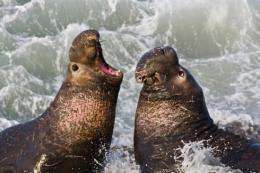Seals mating at sea give beachmaster the slip

Life for elephant seals is nasty and brutish—but their sex lives are legendary.
Only the biggest and most brutish males are believed to reproduce. During the annual breeding season, huge males, called beachmasters, rule harems of much smaller females. The beachmaster drives off all male competitors until another big, aggressive male comes along and dethrones him. It is believed to be one of nature's purest examples of polygyny.
In this case, evolution favors the strongest and biggest.
It turns out those helpless females may not be so helpless, at least in one colony. Large numbers of female Southern elephant seals at the edge of Antarctica are ignoring the polygyny system in favor of sex in the high seas.
But evolution may also favor the wisest.
Researchers from Australia and South Africa have found that large numbers of female seals skip the yearly breeding interval at Marion Island, approximately located between the two continents of Africa and Antarctica. When they finally do show up, they are pregnant, and the beachmaster had nothing to do with it. Almost three-fourths of the males skip the violence and frustration as well.
955 miles off the African coast, Marion Island is a wildlife preserve full of seals, penguins and seabirds that is administered by South Africa. According to Nico de Bruyn, a marine mammal ecologist at the University of Pretoria, the seals come to land twice a year: once to molt, the other to reproduce. Both tasks are much easier to do on solid land than in the tossing ocean.
Male bull elephant seals are enormous, some measuring 16 feet long and weighing more than 3 short tons. They have a proboscis, or trunk, almost a foot long, hence the elephant in their name. They are loud, smelly and mean-tempered.
Female elephant seals are one-fourth the weight and up to 6 feet shorter than males.
The seals employ delayed implantation, meaning the fertilized egg does not implant itself and begin development until the timing is exactly correct for the pup to be born on land, a 12-month gestation period including the delay. On Marion Island, that is in October, de Bruyn said. All the pups are born within days of each other.
Females nurse the young for only about three weeks and are then ready to reproduce again. The bulls, alpha males, are so large many females and pups are killed when an amorous or bellicose bull lands on them. On the crowded beach there is no place to escape.
But the researchers, reporting in Animal Behavior, have found that as many as half the females refuse to play along, staying in the ocean and mating with whom they chose rather than joining the chaos on the beach.
"For a male, even if he is huge in comparison to the female—which they are—coercing a female is so much more difficult in the water because she has more options," de Bruyn said.
The researchers began their work of marking and capturing animals because of concern about a dramatic decline in Southern elephant seals noted in the 1980s. The population at Marion Island was down 80 percent for reasons unknown, although de Bruyn said that it has stabilized now and is even showing a slight increase.
De Bruyn does not think this evasion of is new behavior.
Oddly, that behavior is not seen in other elephant seal colonies. Daniel Costa, professor of ecology and evolutionary biology at the University of California, Santa Cruz, studies the Northern elephant seals that breed at Ano Nuevo on the California coast. He doesn't think that behavior is common.
"We have no evidence that it occurs in Northern elephant seals. I'm not even sure how prevalent the observation is for Southern elephant seals," Costa said. "We know that our females do not hang out in the water. I can say this because we track them onto the beach from sea, or at least the 300-plus females we have tracked don't spend a lot of time offshore. They just come in and land on the beach."
And then end up in some beachmaster's harem.
Provided by Inside Science News Service

















